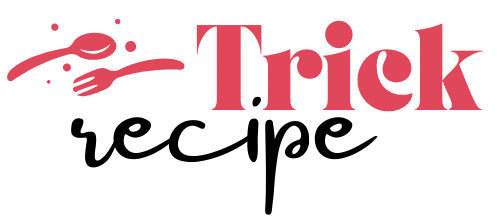Introduction
Looking for a refreshing, nutrient-packed way to kickstart your mornings or refuel after a workout? A pitaya bowl might be just what you need. Made from the vibrant pink flesh of dragon fruit, these smoothie bowls are not only beautiful but also loaded with health benefits. In this guide, we’ll explore everything from what a pitaya bowl actually is, how to make one, why it’s different from an acai bowl, and whether it fits into a healthy diet or weight loss plan.
Let’s get started with the basics—what is a pitaya bowl, and why is it taking over breakfast menus across the country?
Table of content
Table of Contents
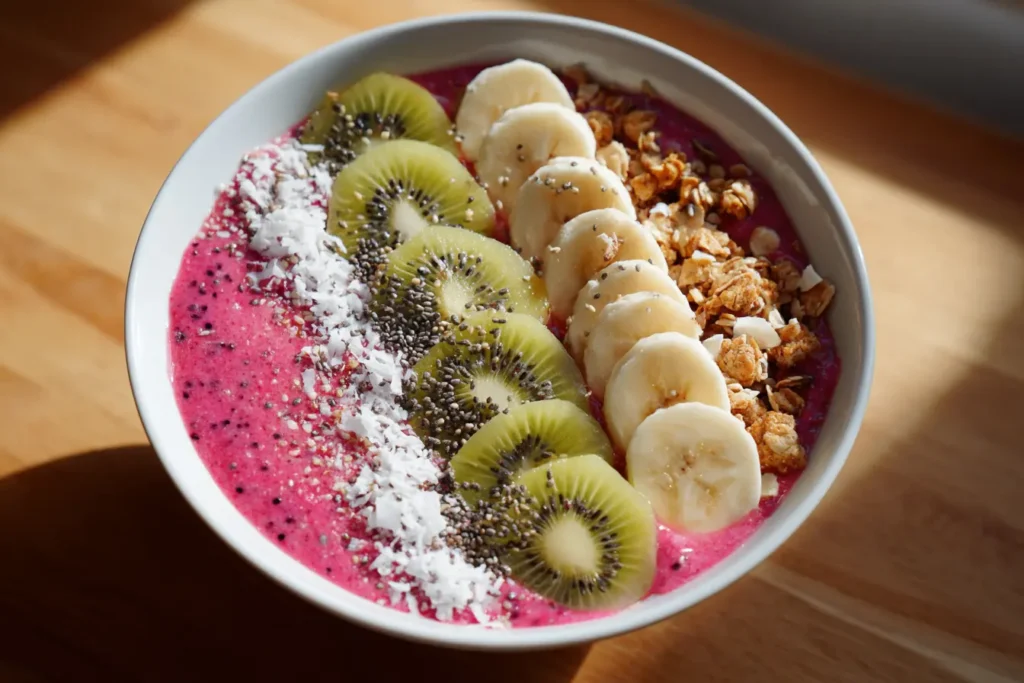
What Is a Pitaya Bowl? A Bright Start to Better Health
Understanding the Origin and Name of Pitaya (Dragon Fruit)
The pitaya bowl, often called a dragon fruit bowl, is a tropical smoothie bowl made using the flesh of the dragon fruit, also known as pitaya. The term “pitaya” comes from Central America, where the fruit has been grown for centuries. With its neon pink hue and speckled seeds, pitaya offers both visual appeal and serious nutritional value. It’s no wonder this exotic fruit has become the star of health-conscious diets around the world.
There are two main types of pitaya: red-fleshed and white-fleshed varieties. The bright magenta type is usually used in a pitaya bowl for its bold color and mildly sweet taste. When blended with other fruits and a splash of liquid, it creates a thick, spoonable smoothie base.
What Makes Pitaya Bowls So Visually and Nutritionally Appealing?
There’s more to a pitaya bowl than just looks—though its bright pink color is definitely eye-catching. The appeal lies in its versatility and nutritional richness. A standard pitaya bowl includes blended frozen pitaya, bananas, berries, and a splash of coconut water or almond milk, topped with granola, seeds, and more fresh fruit.
Visually, the pitaya bowl stands out in any Instagram feed, making it popular not just for health but also for lifestyle branding. Nutritionally, it’s packed with antioxidants, vitamin C, magnesium, and fiber. These nutrients support skin health, digestion, and even your immune system.
The pitaya bowl is not just another smoothie—it’s a superfood powerhouse that works as a meal replacement or a vibrant post-workout recovery snack.
Pitaya Bowl Ingredients – What’s Inside This Superfruit Delight?

Core Components: Pitaya, Fruits, Liquid Base, Toppings
The heart of any pitaya bowl is, of course, the vibrant dragon fruit itself. Most recipes use frozen red-fleshed pitaya for its rich color and creamy texture. From there, the possibilities are endless—but most bowls start with a few key staples:
| Ingredient | Purpose |
|---|---|
| Frozen Pitaya | Main smoothie base, rich in antioxidants |
| Banana or Mango | Natural sweetness and creamy consistency |
| Berries (Strawberries, Blueberries) | Flavor depth and added vitamins |
| Liquid (Coconut Water, Almond Milk) | Helps with blending and adds nutrients |
Toppings are where a pitaya bowl really comes to life. Popular choices include:
- Granola – Adds crunch and whole grains
- Chia Seeds or Flaxseeds – Boosts fiber and omega-3s
- Fresh Fruit Slices – Enhances flavor and visual appeal
- Shredded Coconut or Nut Butters – Healthy fats and protein
These components work together to make a pitaya bowl not just delicious, but also nutrient-dense and satisfying.
Optional Add-ons and Protein-Packed Mix-ins
Want to boost the health benefits of your pitaya bowl even further? Consider adding protein and superfood upgrades:
- Greek Yogurt or Protein Powder – Perfect if you’re using your bowl as a meal replacement or post-workout snack
- Collagen Peptides – Support skin, joints, and hair
- Hemp Seeds or Sunflower Seeds – Rich in plant-based protein and healthy fats
- Spirulina or Maca Powder – Popular adaptogens with energy-boosting properties
Each of these add-ins can enhance both the flavor and function of your pitaya bowl, helping tailor it to your specific health needs or dietary goals.
Don’t miss our Acai Smoothie Recipe if you’re curious how pitaya compares with other smoothie options!
Pitaya Bowl vs Acai Bowl – Which Is Better?
Key Differences in Fruit, Taste, and Nutrition
When it comes to superfruit smoothie bowls, two names always rise to the top: pitaya bowl and acai bowl. Though they may look similar, they’re not the same—and choosing the right one depends on your taste preferences and nutritional goals.
A pitaya bowl uses dragon fruit as the base, known for its mild sweetness, high water content, and vibrant pink hue. On the other hand, acai bowls use acai berries, which are deeper in color and have a richer, slightly earthy taste with a hint of chocolate.
Here’s a quick comparison of the two:
| Feature | Pitaya Bowl | Acai Bowl |
|---|---|---|
| Color | Bright pink | Deep purple |
| Taste | Mildly sweet | Tart, earthy |
| Calories | Lower | Slightly higher |
| Sugar (Natural) | Slightly higher | Lower |
| Fiber | High | Very high |
| Antioxidants | Rich in vitamin C | Loaded with anthocyanins |
Both are excellent smoothie options, but a pitaya bowl may be more hydrating and lighter in texture, making it a great pick for those wanting a refreshing post-workout meal.
Acai vs Pitaya: Antioxidants, Sugar, and Health Effects
When it comes to antioxidant power, both bowls deliver big. Acai berries are especially praised for their anthocyanin content—great for heart health and brain function. However, pitaya is packed with vitamin C, magnesium, and phytonutrients, making the pitaya bowl a great immune-boosting option.
In terms of sugar, pitaya contains more natural sugar than acai, but it’s balanced by its water content and fiber. That makes a pitaya bowl easier to digest and less dense, which is ideal for people who prefer a lighter, energizing meal.
Looking for inspiration? Try this energizing Lemon Balm for Weight Loss recipe as a complement to your pitaya bowl for even better fat-burning support.
How to Make a Pitaya Bowl at Home (Step-by-Step Recipe)
Print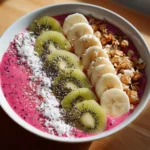
Pitaya Bowl: The Best 2025 Superfruit Smoothie
- Total Time: 5 mins
- Yield: 1 large serving
Description
A vibrant, antioxidant-rich pitaya bowl made with frozen dragon fruit, tropical fruits, and healthy toppings. Perfect for a refreshing breakfast, post-workout meal, or midday energy boost.
Ingredients
- 1 frozen pitaya (dragon fruit) pack (100g)
- 1 frozen banana
- ½ cup frozen mango or strawberries
- ¼ to ½ cup unsweetened almond milk or coconut water
- (Optional) 1 scoop of vanilla protein powder or collagen peptides
Instructions
In a high-speed blender, combine frozen pitaya, banana, mango, and ¼ cup liquid.
Blend on low, gradually increasing speed. Use a tamper or spoon to help blend evenly.
Add more liquid if needed to reach a thick, spoonable consistency.
Pour smoothie mixture into a bowl.
Add your favorite toppings such as granola, chia seeds, sliced fruits, and coconut.
Serve immediately and enjoy your nutrient-packed pitaya bowl!
- Prep Time: 5 mins
- Cook Time: 0 mins
- Category: Weight Loss Meals
Blending Tips for the Perfect Thick Smoothie Texture
Making a pitaya bowl at home is easier than you think—and it’s often better than what you’d buy at a smoothie bar. The secret lies in using frozen ingredients and just the right amount of liquid. Here’s a simple base recipe:
Basic Pitaya Bowl Recipe
| Ingredient | Quantity |
|---|---|
| Frozen pitaya (dragon fruit) | 1 pack (100g) |
| Frozen banana | 1 medium |
| Strawberries or blueberries | ½ cup |
| Coconut water or almond milk | ¼ to ½ cup (add gradually) |
| Optional protein powder | 1 scoop |
Steps:
- Add frozen pitaya, banana, berries, and ¼ cup of your liquid into a high-speed blender.
- Blend on low and pulse. Stop frequently to scrape the sides.
- Add a little more liquid if needed, but don’t overdo it—you want a thick texture.
- Once creamy and smooth, pour into a bowl and prepare for toppings.
TIPS:
- Use a tamper or stir regularly if the blender gets stuck.
- The less liquid you use, the thicker your pitaya bowl will be.
- Chill your bowl before serving for a better texture experience.
Check out this quick video tutorial to see the blending technique in action:
▶️ How to Make a Pitaya Bowl (YouTube)
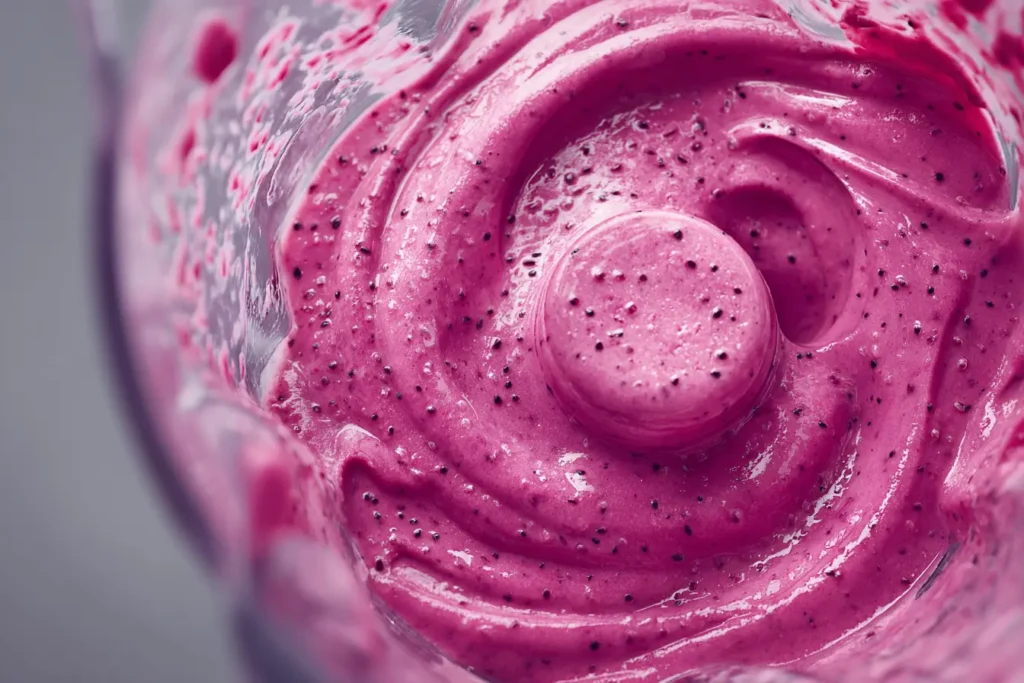
Top Toppings to Try: Granola, Seeds, Fresh Fruit, and More
The toppings are where you can get creative. Want crunch? Go for granola or cacao nibs. Need extra nutrients? Add seeds or nut butter. Here are some ideas:
- Granola – for crunch and fiber
- Fresh strawberries, kiwi, banana slices – for color and nutrients
- Chia or flaxseeds – to boost omega-3s
- Shredded coconut – tropical flavor and healthy fat
- Almond or peanut butter – protein and creamy texture
- Goji berries or cacao nibs – antioxidant punch
The real beauty of a pitaya bowl lies in its flexibility. You can go fruity, protein-packed, or fiber-rich depending on your needs.
Discover great ideas like our Tropical Smoothie Cafe Avocolada Recipe if you’re in the mood to experiment with exotic flavors.
Nutritional Benefits of a Pitaya Bowl
Vitamins, Minerals, and Antioxidant Profile
One of the biggest reasons the pitaya bowl has exploded in popularity is its exceptional nutritional content. Dragon fruit (pitaya) isn’t just beautiful—it’s a low-calorie, antioxidant-rich superfruit loaded with beneficial vitamins and minerals. Here’s what your body gets in every spoonful:
| Nutrient | Benefits |
|---|---|
| Vitamin C | Boosts immunity and skin health |
| Magnesium | Supports muscle and nerve function |
| Fiber | Aids digestion and weight control |
| Iron | Improves blood oxygen levels |
| Antioxidants | Fights inflammation and aging |
A pitaya bowl made with a well-balanced base and toppings can offer over 6 grams of fiber and around 200–300 calories, depending on ingredients. It also contains zero cholesterol and very little fat (unless you add nut butter or seeds), making it ideal for heart health.
And let’s not forget its hydration factor: dragon fruit is over 90% water, which helps you stay refreshed and energized throughout the day.
Gut Health, Hydration, and Low-Calorie Superpowers
Thanks to its fiber content and prebiotic compounds, the pitaya bowl supports digestive wellness by feeding healthy gut bacteria. It can also help prevent constipation and support a smoother metabolism.
Because pitaya is low in calories but high in water and fiber, it leaves you feeling full without overeating. This makes a pitaya bowl a fantastic choice for those trying to manage their weight without sacrificing taste or satisfaction.
Looking for more fat-burning support? Don’t miss our popular What Is the Bariatric Seed Recipe? which pairs perfectly with a morning pitaya bowl for added health benefits.
Is Pitaya Good for Weight Loss and Fitness?
Low-Calorie and Fiber-Packed Benefits
If you’re watching your calories or trying to shed a few pounds, a pitaya bowl can be a delicious and smart addition to your diet. It’s naturally low in calories, yet it fills you up thanks to its high fiber content. One serving of blended dragon fruit typically contains just 60–100 calories and nearly 3 grams of fiber—all without added sugar.
When combined with low-glycemic fruits and clean toppings like chia seeds, almond butter, or unsweetened coconut, a pitaya bowl can support blood sugar stability and reduce cravings between meals.
Here’s why it works so well for weight loss:
- High in fiber – Promotes satiety and reduces overeating
- Low in fat – Helps maintain a calorie deficit
- Hydrating – Keeps you full longer with fewer calories
- Naturally sweet – Satisfies sugar cravings without junk
In short, a well-balanced pitaya bowl is a great meal or snack when you’re aiming to lose weight the healthy way.
Great Pre/Post-Workout Snack Option
Fitness lovers, listen up—a pitaya bowl isn’t just for weight loss. It’s also a powerful pre- or post-workout meal. The combination of carbs from fruit and natural sugars gives you quick energy, while optional add-ins like protein powder or Greek yogurt aid in muscle recovery.
| When to Eat | Why |
|---|---|
| Before workout | Provides energy from natural carbs |
| After workout | Aids recovery when topped with protein sources |
| As breakfast | Keeps you energized and full throughout the day |
If you’re serious about fitness, pairing your pitaya bowl with a glass of Apple Tea for Weight Loss can help you tap into even more natural fat-burning power.
Pitaya Bowl Recipe Variations You’ll Love
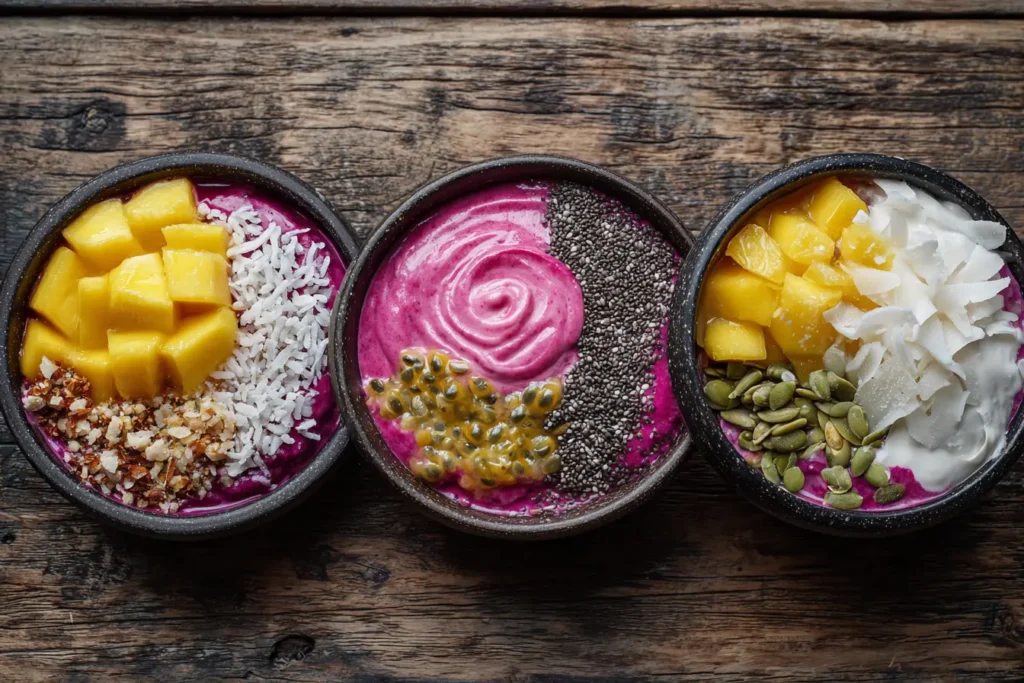
Tropical Twist: Mango + Coconut Blend
Craving something island-inspired? Turn your basic pitaya bowl into a tropical delight by adding mango, pineapple, and coconut milk. This version is bursting with vitamin C, natural sweetness, and beachy vibes.
Tropical Pitaya Bowl Recipe Idea:
- Base: Frozen pitaya, frozen mango, pineapple chunks, coconut milk
- Toppings: Shredded coconut, kiwi slices, granola, chia seeds
This pitaya bowl variation not only satisfies your sweet tooth naturally, but it also packs in hydration and nutrients perfect for hot summer days.
Keto-Friendly Pitaya Bowl Swaps
Trying to cut carbs but still want a bowl that pops? Modify your pitaya bowl for keto with a few smart substitutions:
- Replace bananas with avocado or frozen zucchini for a creamy base
- Add unsweetened almond milk and sugar-free vanilla protein powder
- Top with hemp seeds, cacao nibs, and chopped nuts instead of sugary granola
Though dragon fruit does contain natural sugars, its glycemic load is low, making it manageable in moderation for low-carb eaters.
High-Protein Pitaya Bowl with Greek Yogurt
If you’re focused on fitness or meal prepping, protein is key. Blend Greek yogurt into your pitaya bowl for a thicker, tangier base with added staying power.
Protein-Packed Pitaya Bowl:
- Base: Frozen pitaya, banana, scoop of protein powder, ½ cup Greek yogurt
- Toppings: Sliced almonds, blueberries, pumpkin seeds
This bowl can deliver 15–25g of protein in one serving—making it perfect as a post-workout meal or hearty breakfast.
Whether you’re going tropical, keto, or protein-powered, a pitaya bowl can be adjusted to match your dietary goals while keeping things fun and flavorful.
Where to Buy Pitaya or Ready-to-Eat Pitaya Bowls
Best Frozen Pitaya Packs and Supermarket Options
If you’re ready to make your own pitaya bowl at home, the first step is finding quality frozen dragon fruit. Fortunately, frozen pitaya packs are widely available at most major grocery stores in the U.S. Here are some top options:
| Store | Product | Form |
|---|---|---|
| Trader Joe’s | Organic Frozen Pitaya Chunks | Cubed |
| Whole Foods | Pitaya Foods Smoothie Packs | Pouch |
| Target | Good & Gather Pitaya | Cubes or packs |
| Walmart | Sambazon Dragon Fruit Packs | Smoothie-ready |
These pre-frozen pitaya options are great because they’re easy to use—just tear open, blend, and go. When shopping, always check the ingredient list. The best pitaya bowl bases use only pitaya—no added sugars or preservatives.
Also, don’t forget your local health food store or farmer’s market. Some places even carry fresh pitaya (dragon fruit), which you can slice and freeze yourself.
Smoothie Cafes vs. Homemade – Cost & Quality Breakdown
While smoothie cafes are convenient, making your own pitaya bowl can be healthier and way more affordable. Here’s how the two compare:
| Factor | Smoothie Cafe Bowl | Homemade Pitaya Bowl |
|---|---|---|
| Cost | $9–$13 per bowl | $3–$5 per bowl |
| Customization | Limited | Fully customizable |
| Sugar Levels | Often high (hidden) | Controlled by you |
| Ingredients | May include fillers | Whole foods only |
If you’re someone who enjoys control over your ingredients, portion sizes, and budget, homemade is the way to go. You can experiment with different bases, toppings, and nutrients to create the perfect pitaya bowl tailored just for you.
Looking for inspiration? Try pairing your homemade creation with our Baking Soda Trick for Men Recipe—a trending natural health hack that complements a detox-focused meal.
Storing and Serving Pitaya Bowls Right
How to Store Leftover Smoothie Bowls Without Losing Texture
Let’s face it—sometimes we make too much, or we want to prep ahead. So how do you store your pitaya bowl without it turning into a soupy mess?
Here’s how:
- Refrigerator (Short-Term): Transfer leftover pitaya bowl to an airtight glass container and refrigerate for up to 24 hours. The color will stay vibrant, but the texture will become softer. Give it a quick stir before eating.
- Freezer (Long-Term): Store in a freezer-safe container with minimal air space. When you’re ready to enjoy it again, thaw slightly and re-blend to restore that thick consistency.
| Storage Method | Time Limit | Tip |
|---|---|---|
| Fridge | 24 hours | Stir before serving |
| Freezer | Up to 2 weeks | Re-blend for best results |
To make storing even easier, pour your pitaya bowl base into silicone molds or jars for grab-and-go portions.
Best Time to Eat Pitaya Bowls for Health Benefits
When you eat your pitaya bowl can make a difference in how your body uses its nutrients. Here’s a quick guide:
- Morning: Perfect as a breakfast or first meal—it hydrates, energizes, and keeps you full for hours.
- Post-Workout: Refuels your muscles with clean carbs and optional protein.
- Midday Snack: A colorful way to fight cravings and avoid sugar crashes.
One of the best things about a pitaya bowl is its adaptability. Whether you’re eating to fuel your body or satisfy a craving, there’s never a bad time to enjoy this vibrant, nourishing bowl.
Looking for inspiration? Try pairing your chilled pitaya leftovers with our Emily Martinez Natural Mounjaro strategy for a complete health-boosting routine.
FAQ: Pitaya Bowl Questions Answered
What is a Pitaya Bowl made of?
A pitaya bowl is typically made from frozen dragon fruit (pitaya), blended with fruits like banana, mango, or berries, and a splash of liquid such as almond milk or coconut water. It’s topped with granola, seeds, fresh fruit, and other nutritious add-ons like nut butter or coconut flakes. This combination creates a vibrant, thick smoothie bowl that’s as beautiful as it is healthy.
What is a Pitaya Bowl vs Acai Bowl?
While both bowls are antioxidant-rich smoothie meals, a pitaya bowl uses dragon fruit as its base, offering a bright pink color and a mildly sweet flavor. In contrast, acai bowls use acai berries, which have a deeper purple hue and a richer, more earthy taste. Nutritionally, pitaya bowls are lower in calories and sugar, while acai bowls often contain more fiber and heart-healthy anthocyanins.
Are pitaya bowls healthy for you?
Absolutely. A pitaya bowl is packed with vitamin C, magnesium, fiber, and antioxidants. It supports digestion, boosts the immune system, and is hydrating. When made without added sugars and topped with wholesome ingredients, it’s a nutrient-dense meal or snack that fits well into most healthy diets.
Are dragon fruit and pitaya the same thing?
Yes. Pitaya is another name for dragon fruit. Both terms refer to the same tropical fruit from cactus species. The word “pitaya” is commonly used in Central and South America, while “dragon fruit” is more widely recognized in English-speaking countries. No matter what you call it, it’s the star of every pitaya bowl.
Conclusion: Why the Pitaya Bowl Deserves a Spot in Your Diet
Whether you’re seeking a healthy breakfast, a post-workout refuel, or a visually stunning snack, the pitaya bowl checks every box. It’s hydrating, energizing, packed with nutrients, and endlessly customizable. Plus, it’s one of the most Instagram-worthy meals you can make in under 10 minutes.
